Years of service 19441945 | Name Franklin Sousley | |
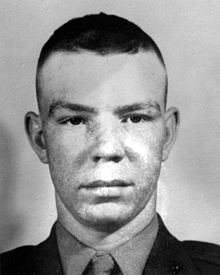 | ||
Born September 19, 1925Hill Top, Kentucky ( 1925-09-19 ) Place of burial Originally on Iwo Jimalater reinterred in Elizaville Cemetery, Kentucky Battles/wars World War IIBattle of Iwo Jima Died March 21, 1945, Iwo Jima, Japan Parents Merle Duke Sousley, Goldie Mitchell Siblings Julian Sousley, Malcolm Brooks Sousley Similar People | ||
Pfc franklin sousley on iwo jima
Franklin Runyon Sousley (September 19, 1925 – March 21, 1945) was a United States Marine who was killed in action during the Battle of Iwo Jima in World War II. He is best known for being one of the six flag-raisers who helped raise the second U.S. flag atop Mount Suribachi on February 23, 1945 as shown in the iconic photograph Raising the Flag on Iwo Jima.
Contents
- Pfc franklin sousley on iwo jima
- Franklin Sousleys Grave
- Early life
- US Marine Corps
- Battle of Iwo Jima
- Marine Corps War Memorial
- Portrayal in film
- Military awards
- Honors
- References

The Marine Corps War Memorial located in Arlington, Virginia, which was modeled after the flag-raising photograph, depicts bronze statues of each of the six Marine flag-raisers.
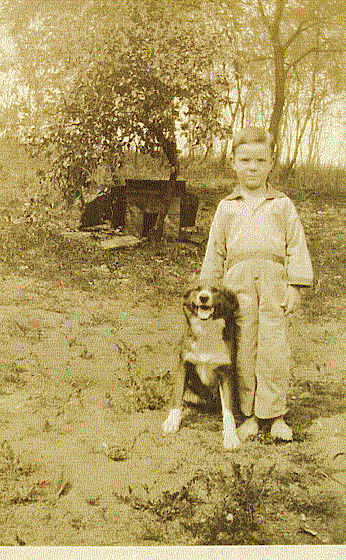
Franklin Sousley's Grave
Early life
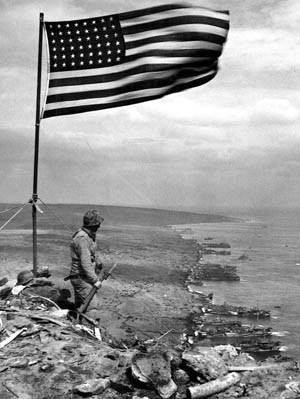
Sousley was born in Hill Top, Kentucky, the second child born to Merle Duke Sousley (1899–1934) and Goldie Mitchell (November 9, 1904 – March 14, 1988). When he was two years old, his five-year-old brother, Malcolm Brooks Sousley (November 24, 1923 – May 30, 1928), died due to appendicitis. Franklin attended a two-room schoolhouse in nearby Elizaville, and attended Fleming County High School in nearby Flemingsburg from ninth to twelfth grade. His younger brother Julian was born in May 1933, and his father died due to diabetes complications a year later, at age 35. At only nine years old, Franklin was the sole male-figure in the family, and assisted his mother in raising Julian. Julian died in a car accident on 4 October 1951, at the age of 18. Sousley graduated from Fleming High School in May 1943, and resided in Dayton, Ohio as a worker in a refrigerator factory.
U.S. Marine Corps
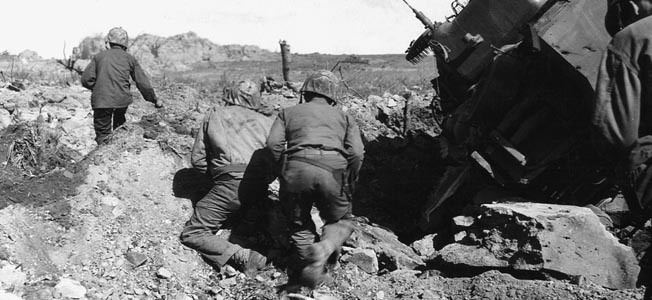
Sousley received his draft notice, and chose to join the United States Marine Corps on January 4, 1944. Later, he underwent extensive combat training in California and Hawaii as a member of the E Company, 2nd Battalion, 28th Marine Regiment, Fifth Marine Division.
Battle of Iwo Jima

Flag raising(s)
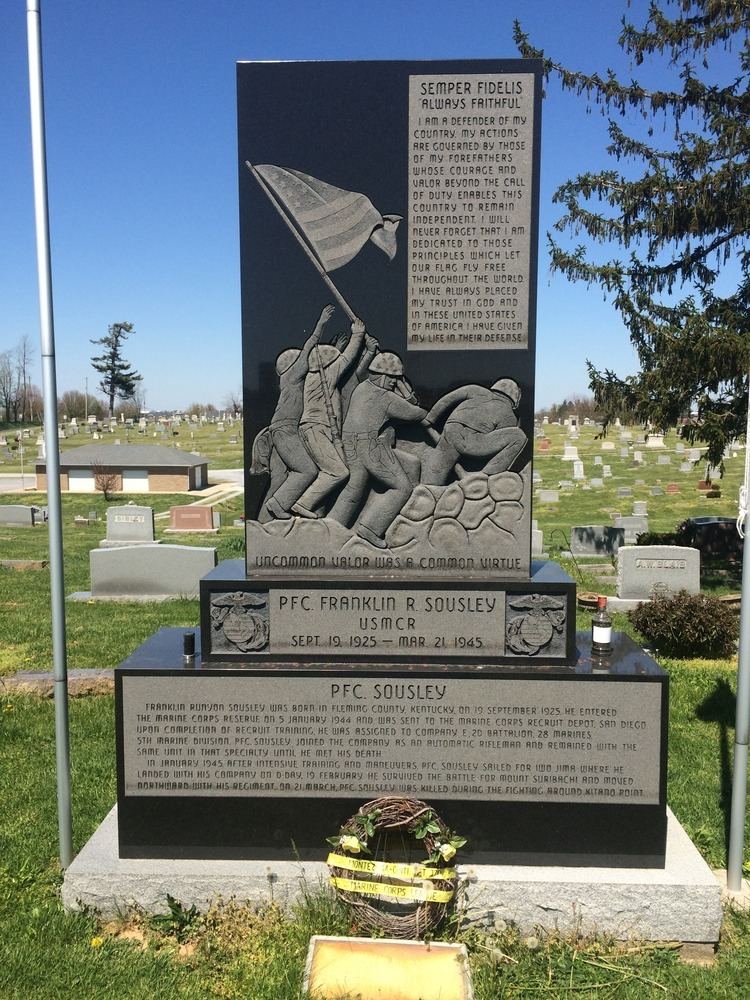
Sousley landed with his unit at the southeast end of Iwo Jima near Mount Suribachi which was the 2nd Battalion, 28th Marines objective on February 19, 1945, and fought in the battle for the capture of the island. At 8 AM, On February 23, a 40-man patrol (mostly from Third Platoon, Easy Company) led by E Company's executive officer, First Lieutenant Harold Schrier, was sent up Mount Suribachi to seize and occupy the crest. Schrier who volunteered to lead the patrol, was to raise the battalion's American flag to signal that the mountaintop was captured. The patrol reached the top and the flag was raised by Lt. Schrier, Platoon Sergeant Ernest Thomas, and Sergeant Henry Hansen approximately 10:30 AM.
Around noon, Marine Sgt. Michael Strank, a squad leader of Second Platoon, Easy Company, was ordered by his company commander to take three Marines from his rifle squad and raise a larger replacement flag on top of Mount Suribachi. Strank chose Cpl. Harlon Block, Pfc. Ira Hayes, and Pfc. Franklin Sousley. On the way up the four Marines laided telephone communication wire (or took supplies up). Pfc. Rene Gagnon, the Second Battalion's runner (messenger) for Easy Company, was ordered by the battalion commander to take the replacement flag up the mountain and return with the first flag.
Once on top, Strank ordered Hayes and Sousley to find a steel pipe to attach the replacement flag unto. After a Japanese iron pipe was found and the flag attached to it, Strank, Block (Block was misidentified as Sgt. Hansen, until January 1947), Hayes, and Sousley assisted by Gagnon and Pfc. Harold Schultz (on June 23, 2016, the Marine Corps announced that Navy Corpsman John Bradley was not in Rosenthal's photo and Schultz was) raised the replacement flag at approximately 1 PM as the first flagstaff was lowered under Lt. Schrier's orders. Strank had called to Gagnon and Schultz to help raise the heavy flagstaff. Once raised, the flagstaff was secured by rocks, and rope tied to it in three places (Bradley assisted some Marines in this) and staked into the ground due to the very high winds on Mount Suribachi.
The second raising was immortalized forever by the black and white photograph of the flag raising by Joe Rosenthal of the Associated Press. Marine photographer Sergeant Bill Genaust also filmed this flag raising in color. In March 1945, Genaust, Thomas and Hansen (first flag-raisers), Strank, Block, and Sousley were killed in action on Iwo Jima.
Death
On March 30, 1945, the Marine Corps was ordered by President Franklin Roosevelt (after he saw Rosenthal's photo in the newspapers and the battle was over on March 26) to send the flag raisers in Rosenthal's photo to Washington D.C. to participate in a much needed war bond selling tour. Strank and Block were killed on March 1 and Sousley on March 21. The book Flags of Our Fathers (2000) by James Bradley (son of Navy corpsman John Bradley who accompanied the 40-man patrol up the mountain), says Sousley was shot in the back by a Japanese sniper as he was walking down an open road which was a known area of enemy sniper fire, and speculated that he lost his focus or thought the Japanese had stopped firing. According to the book, a fellow Marine saw Sousley lying on the ground and asked, "How bad are you hit?" Sousley's last words were, "Not bad, I can't feel a thing." He then died of his injuries. However, Rene Gagnon, who knew Sousley personally for several months and saw Sousley the day he was killed, had signed an affidavit for the Marine Corps reporting that Sousley was killed instantly.
Sousley's body was originally buried at the 5th Marine Division Cemetery on the island of Iwo Jima. A service was held there in the morning of March 26 by the division's surviving Marines which included Ira Hayes and other members of Sousley's company and platoon before they departed Iwo Jima that day. Sousley's remains were reinterred on May 8, 1947, in Elizaville Cemetery in Fleming County, Kentucky.
Marine Corps War Memorial
The Marine Corps War Memorial (also known as the Iwo Jima Memorial) in Arlington, Virginia which was inspired by Rosenthal's photograph of the second flag-raising on Mount Suribachi was dedicated on November 10, 1954. Sousley is depicted as the third bronze statue from the bottom of the flagstaff with the 32 foot (9.8 M) bronze statues of the other five flag-raisers on the monument (Harold Schultz is depicted as the fifth bronze statue from the bottom of the flagstaff).
President Dwight D. Eisenhower sat upfront with Vice President Richard Nixon, Deputy Secretary of Defense Robert Anderson, and General Lemuel C. Shepherd, the 20th Commandant of the Marine Corps during the dedication ceremony. Two of the three surviving flag-raisers depicted on the monument, Ira Hayes and Rene Gagnon, were seated together with John Bradley (he was incorrectly identified as a suriviving flag-raiser) in the front rows of seats along with relatives of those who were killed in action on the island. Speeches were given by Richard Nixon, Robert Anderson who dedicated the memorial, and General Shepherd who presented the memorial to the American people. Inscribed on the memorial are the following words:
In Honor And Memory Of The Men of The United States Marine Corps Who Have Given Their Lives To Their Country Since 10 November 1775Portrayal in film
In the 1961 film The Outsider, starring Tony Curtis as Ira Hayes, the fictional character James B. Sorenson (Hayes's Marine buddy in the movie), portrayed by actor James Franciscus, was a composite based primarily on Franklin Sousley.
In the 2006 film Flags of Our Fathers, about the six flag raisers on Iwo Jima, Franklin Sousley was portrayed by actor Joseph Michael Cross. The film is based on the 2000 book of the same title.
Military awards
Sousley's military decorations and awards:
Note: The Marine Corps Good Conduct Medal required 4 years service during the World War II time period.
Honors
There is a small Franklin Sousley memorial in the Fleming County Public Library, Flemingsburg, Kentucky.
